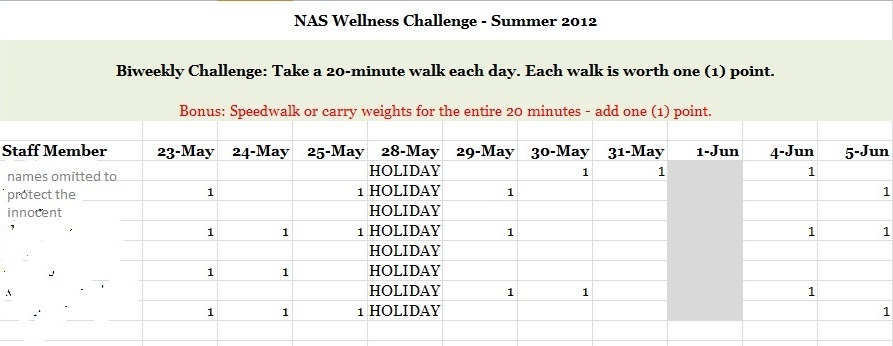No alcohol for 30 days! Daily workouts! Low carb from now on!
It’s a new year, and like every January, many of us are guilt-stricken over holiday indulgences and bad habits. We resolve that this year, we will be better. But inevitably and despite our best efforts, life takes over. February 15 comes around and we’re back on the bread, feeling even guiltier than we did on New Year’s Day.
While personal change is on many of our minds right now, creating change in our work can be just as difficult. What can we learn from personal efforts that might influence the way we go about effecting change in our organizations?
Making a substantial change takes time, consistency, and sometimes a slip up or two to get you back on track. Forming a habit or creating change that lasts can also be much easier when the activity is reinforced by a routine and championed by a group. As evidenced by Alcoholics Anonymous, structure, accountability and positive reinforcement can go a long way in helping a habit stick.
Over the past year at National Arts Strategies, we’ve experienced a change in how we incorporate wellness into our workdays. This was a change spurred by many factors. We were acutely aware of the dangers of sitting at work, thanks to a plethora of articles about how our office jobs are killing us by way of comfy, ergonomic desk chairs. We work in an open office environment, and while the shared work space is great for our team’s cross-functional nature and for sharing ideas, it means we don’t need to get up and walk to another office or area of the building in order to engage with someone. That little activity may not seem like much, but by mid-afternoon, many of us felt a marked drop in energy. We read about our neighbors upstairs at The Motley Fool and the company’s investment in workplace wellness. Fitness classes! Personal training! Workout buddies! Healthy snacks! Man, were we jealous, and inspired to make a change.
When my colleague and avid yogi Sunny Widmann took a turn leading our staff meetings, she chose to start each meeting by leading the group through in a simple yoga pose. This helped center us and bring us into the room for the meeting. So when it was my turn to chair staff meetings, I wanted to introduce a new wellness initiative to the team that would extend past staff meetings and into our overall culture.
Encouraged by the positive response to staff meeting yoga and my colleagues’ readiness to do more, I decided to start a wellness challenge as a vehicle to help us change our everyday habits. I wanted to provide some ideas for activities that we could easily integrate into our work to create some positive habits and shifts in how we treated our bodies every day, not just momentary breaks. Small activities were also a way to introduce change in a way that was not imposing or overwhelming. I did a bit of research about ways to incorporate activity into the workday, and asked a few colleagues to join me in a brainstorming session to come up with some ideas for physical activity. This helped me in designing the challenge and also brought others on board to help champion the change I was about to introduce.
We chose activities that could be modified for those with any physical concerns, things that could be done within and around our office building and also by those working from home and activities that wouldn’t occupy too much time. We came up with three categories of activity – strength, stretching and cardio – and I decided to feature a new activity every two weeks for my three-month challenge, long enough to get used to an activity but with enough variation that we didn’t get bored. I created a spreadsheet for team members to track each biweekly activity, and they could also choose to participate in bonus activities to earn additional points.

A few months later, not all of our changes have lasted. While “walk and talks” are still common, we’ve become a bit lax in the energy we devote to wellness. Despite the benefits I realized from thought walks (thanks to Arts for LA for the link), I often forget to take them. My recently adopted, eight-month old puppy Basil gives me a no-excuses-allowed schedule for morning and evening walks and I attend “boot camp” three mornings a week, but the energy boost doesn’t last past lunch, no matter how much kale (or coffee) I consume. I even felt so guilty for sitting while writing this post that I got up and moved to the standing desk, which I often forget to utilize. Several of my colleagues have expressed similar sentiments to me and have even requested that I bring back the challenge, so with the start of a new year, I’m brainstorming some new ways to encourage physical activity at NAS.
While a spreadsheet wasn’t the best way to track for this group, we learned that some structure is necessary to keep an initiative like this going strong, as it is for any organizational change. When introducing change, whether cultural, structural or operational, it is important to have a champion that will consistently encourage a new behavior or way of operating over an extended period of time by advocating for the change and engaging others through the change process. This change leader also has to be flexible, knowing that some trial and error may be necessary to determine what methods will best support and encourage the change, but recognizing that each failed prototype brings you that much closer to the right answer.
Over the next few months, the NAS team will be sharing some additional perspectives on wellness initiatives and how they can be helpful to productivity and improve work-life balance as well as finding the appropriate place of wellness initiatives in a business environment. Does your organization support wellness in the workplace? How does a commitment to wellness help your work?


